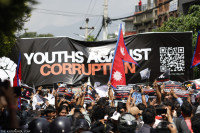Opinion
Responding to disasters
The media’s role is vital in informing people about what to do before, during and after natural disasters
Meera Rajbhandari Amatya
Disaster is a sudden accident or a natural calamity which causes great damage or loss of life. It is a natural or man-made (or technological) hazard resulting in substantial physical damage or destruction, deaths or drastic changes in the environment. Various reports show that developing countries incur the greatest costs when a disaster strikes—more than 95 percent of all deaths caused by disasters occur in developing countries. And losses due to natural disasters are 20 times greater in developing countries than in industrialised countries. Natural disasters do not just cause destruction on land, they also disrupt people’s lives, ruining the development of countries.
Nepal is highly prone to natural disasters such as floods, landslides, fires, extreme weather events and earthquakes. Every year, on average, natural disasters take 951 lives and damage property worth Rs 1.2 trillion, according to a report prepared by ICIMOD. From 1971 to 2010, there have been 15,880 natural disasters in which 29,310 people died and 55,172 were injured. The Seti River flood which occurred on May 5, 2012 in Machhapuchhre VDC of Kaski district took the lives of over sixty people and many from Sardi Khola, Kapuche, Bhalaudi were displaced. The disaster caused damages worth over Rs 49 million.
Managing disasters
Though natural disasters are beyond human control, proper management and preparedness can minimise the disintegration of human and physical elements. Many papers presented at the ‘Locked in Growth Patterns: Rethinking land, water and disasters for the post-2015 Development Agenda’ conference, hosted by Jawaharlal Nehru University in New Delhi in 2013, concluded that disasters are an ongoing natural process that cannot be stopped forever. But better management can minimise their ruin. In the conference, India declared that that it would do more to minimise the ruin caused by disasters like tsunamis. The Indian government has developed a strategy to cope with such disasters, as was mentioned in the speech given by Indian Minister of State for Human Resources Development Shashi Tharoor. The Indian government learnt lessons from the impact of the Indonesian tsunami in 2004. So it has established focal points and pre-information centres which can easily inform and alert people about an imminent tsunami eight hours in advance. According to Tharoor, it will prompt people in the Andaman and Nicobar islands about an upcoming tsunami within half an hour.
Media’s role during disasters
In Nepal, the Ministry of Home Affairs (MoHA) is the key agency responsible for immediate response during disasters. The relief work following a major disaster in Nepal is guided by the Natural Calamity Relief Act 1982, which is implemented under the Natural Disaster Response Framework. The Act was prepared for the effective coordination and implementation of disaster preparedness and response activities through the National Disaster Response Plan, which elucidates the roles and responsibilities of the government and NGOs involved in disaster risk management.
Despite the existence of such a mechanism, victims of disaster are unable to obtain immediate relief when calamity strikes and could be doubly victimised. It can also result in conflicts between different stakeholders. For instance, during the Darchula flood in 2013, flood victims demonstrated against the state expressing dissatisfaction over the distribution of relief. On the contrary, during the Seti flood in Kaski, local FM stations informed victims about rescue and relief funds. During the flood and post-disaster, the media played a vital role in creating awareness about risks, facilitated victims’ access to compensation through broadcasting and called upon people to help in the rehabilitation of victims.
For the rehabilitation and rescue of the victims of the Seti flood, the local media collected about Rs 10 million. The fund was collected from listeners, readers, well-wishers, businesspeople, tourists, students, clubs, local aama samuhas, Non-Residential Nepalis and though campaigns on Facebook and Twitter. The impact of the disaster could have been worse if local FM stations had not immediately informed people about the flood.
Similarly, in Bangladesh, community radios were able to minimise the devastation of disasters through awareness and information according to a paper presented at the conference in Delhi. The conference concluded that the media can play a vital role in disaster management by creating awareness and helping create and manage relief funds pre- and post-disaster.
Coordination matters
Sadly, there is no special plan pursued by the government to promote the media in Nepal. Nonetheless, MoHA has a strategy to coordinate with the media in the National Disaster Response Framework. The framework discusses the Development of an Emergency Communication Strategy in Plan 8.3 but it is not effectively implemented. Furthermore, journalists are invited to very few programmes and meetings that concern the role of the media. This is the reason why the press remains unaware about the strategies being pursued by the government in relation with disaster risks and management.
No one can ever be totally prepared for a natural disaster but knowing what to do before, during and after a disaster can make a crucial difference. The role of the media in disseminating such information is crucial. Furthermore, according to the Nepal Forum of Environmental Journalists, there are several cases where victims have been able to obtain compensation and endowments from the government and NGOs due to media coverage of disasters.
Amatya is President of the Federation of Nepalese Indigenous Nationalities Journalists Association ( FoNIJ ) [email protected]




 8.12°C Kathmandu
8.12°C Kathmandu










